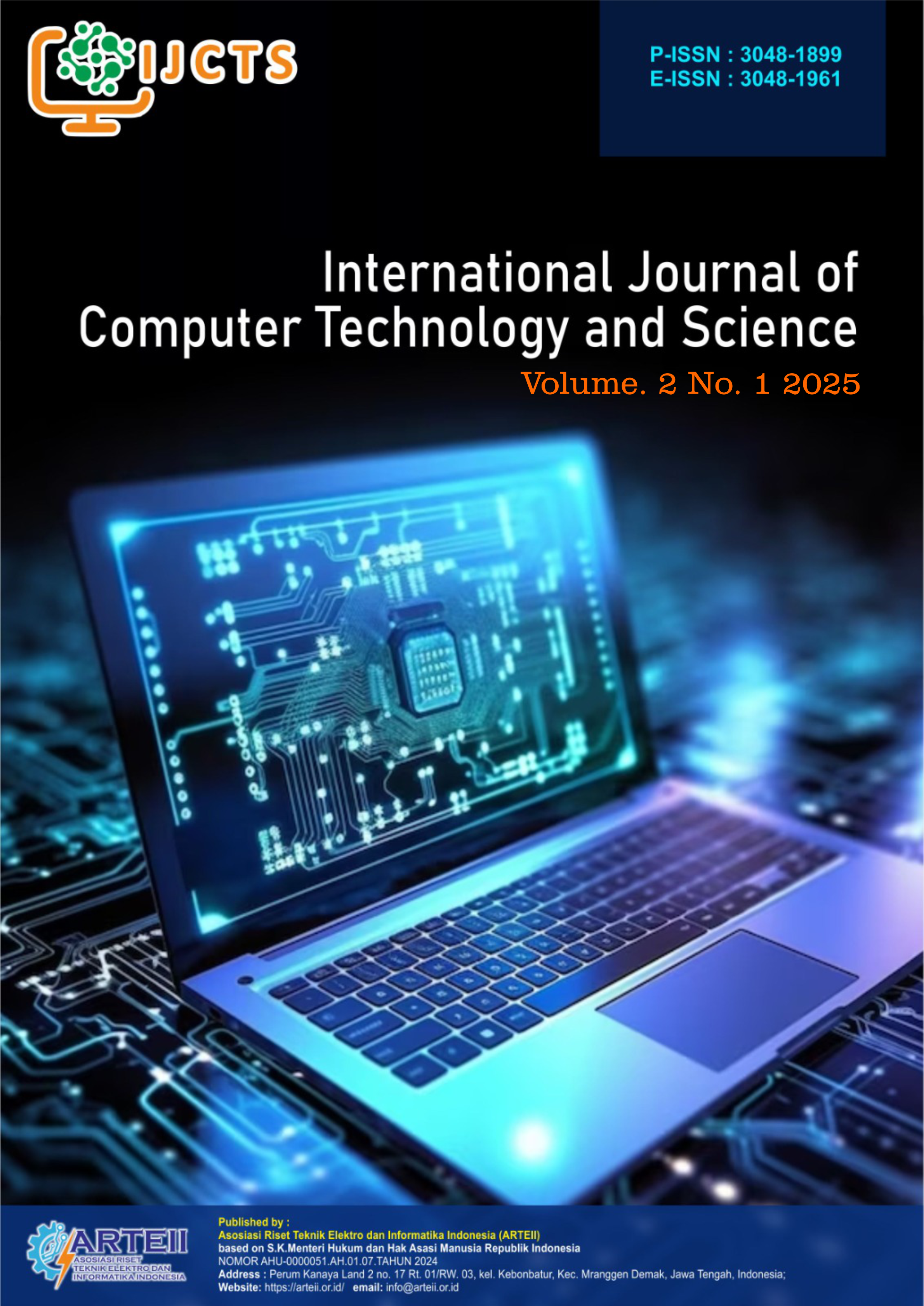Design and Application of PLC-Based Salinocontrol Machine Integrated with IoT for Milkfish Ponds in Ujung Watu Village, Jepara
DOI:
https://doi.org/10.62951/ijcts.v2i3.284Keywords:
IoT, Salinity Control, Salinocontrol Machine, System Automation, PLCAbstract
Milkfish farming in coastal ponds of Ujung Watu Village, Jepara, is highly influenced by the stability of water salinity levels. Significant fluctuations in salinity can interfere with the growth and health of fish, so an adaptive control system is needed. Research methods include field data collection, hardware and software design, and system testing in an active pond for 14 days (23-hour sampling), where data is extracted for 23 hours. The system uses a salinity sensor to detect water conditions, PLC to automatically control the brackish water pump, while wireless remote control uses IoT, in addition to controliing, IoT to send data to the Android-based monitoring platform. The test results show that this machine is able to maintain salinity levels within the optimal range of 10000-30000 ppm, and provide remote monitoring convenience to pond farmers. The monitoring system serves as a predictive for manual wireless control of electric pumps (IoT), while automatic control is controlled by PLC.
References
Amri, K. Karsid, B. Khoerun, I. Fitriyanto, H. Prayietno, and T. Haryanti, Construction of an Automatic Hydroponic Nutrient Control System Based on Arduino Uno, vol. 2023, Atlantis Press International BV, 2024, doi: 10.2991/978-94-6463-364-1_83.
J. H. Huh, “PLC-based design of monitoring system for ICT-integrated vertical fish farm,” Human-centric Computing and Information Sciences, vol. 7, no. 1, 2017, doi: 10.1186/s13673-017-0101-x.
J. Pančík and P. Maxera, “Control of hydraulic pulse system based on the PLC and state machine programming,” Designs, vol. 2, no. 4, pp. 1–10, 2018, doi: 10.3390/designs2040048.
J. Y. Lin, H. L. Tsai, and W. H. Lyu, “An integrated wireless multi-sensor system for monitoring the water quality of aquaculture,” Sensors, vol. 21, no. 24, 2021, doi: 10.3390/s21248179.
Kumar, A. Basit, A. Saleem, and E. G. Abbas, “PLC based monitoring protection of 3-phase induction motors against various abnormal conditions,” 2019 2nd International Conference on Computing, Mathematics and Engineering Technologies (iCoMET), no. April, 2019, doi: 10.1109/ICOMET.2019.8673497.
M. Muñoz-Gómez, M. Menéndez-Marín, J. Ballestín-Fuertes, and J. F. Sanz-Osorio, “Single-Stage Power Converter for Magnetic Field Energy Harvesting to Achieve Self-Powered Smart Grid IoT Devices,” Electronics, vol. 14, no. 3, 2025, doi: 10.3390/electronics14030415.
Meza-Solis, J. Cespedes-Ramos, C. Sotomayor-Beltran, and J. Briones-Zuñiga, “Automated Water Quality Control System for Aquaculture,” International Journal of Engineering Trends and Technology, vol. 73, no. 2, pp. 200–213, 2025, doi: 10.14445/22315381/IJETT-V73I2P117.
O. O. Olanubi, T. T. Akano, and O. S. Asaolu, “Design and development of an IoT-based intelligent water quality management system for aquaculture,” Journal of Electrical Systems and Information Technology, vol. 11, no. 1, 2024, doi: 10.1186/s43067-024-00139-z.
P. R. Kumar, J. Vasudevan, and M. Vengatesh, “Automation of Water Supplying System Using PLC,” International Research Journal of Modern Engineering and Technology and Science, no. 04, pp. 1092–1098, 2023, doi: 10.56726/irjmets35546.
Prafanto, A. Septiarini, N. Puspitasari, M. Taruk, and D. A. Mahendra, “IoT-based Water Quality Control in Tilapia Aquaculture Using Fuzzy Logic,” vol. 2, pp. 57–64, 2024.
Project, F3, no. May, 2023.
R. N. Bashir et al., “Internet of things (IoT) assisted soil salinity mapping at irrigation schema level,” Applied Optics Water Science, vol. 12, no. 5, pp. 1–16, 2022, doi: 10.1007/s13201-022-01619-1.
Richelli, M. Salem, and L. Colalongo, “A review of fully integrated and embedded power converters for IoT,” Energies, vol. 14, no. 17, pp. 1–22, 2021, doi: 10.3390/en14175419.
S. F. A. Bukhari, H. Kahveci, and M. E. Şahin, “Single Phase Induction Motor Driver for Water Pumping Powered by Photovoltaic System,” Electronics, vol. 14, no. 6, 2025, doi: 10.3390/electronics14061189.
T. de Camargo et al., “Low-Cost Water Quality Sensors for IoT: A Systematic Review,” Sensors, vol. 23, no. 9, pp. 1–27, 2023, doi: 10.3390/s23094424.
W. Huang, W. Wan, and H. Liu, “Optimization-based online initialization and calibration of monocular visual-inertial odometry considering spatial-temporal constraints,” Sensors, vol. 21, no. 8, 2021, doi: 10.3390/s21082673.
Y. Pan et al., “Effects of salinity on the growth, physiological and biochemical components of microalga Euchlorocystis marina,” Frontiers in Marine Science, vol. 11, no. May, pp. 1–9, 2024, doi: 10.3389/fmars.2024.1402071.
Downloads
Published
How to Cite
Issue
Section
License
Copyright (c) 2025 International Journal of Computer Technology and Science

This work is licensed under a Creative Commons Attribution-ShareAlike 4.0 International License.





